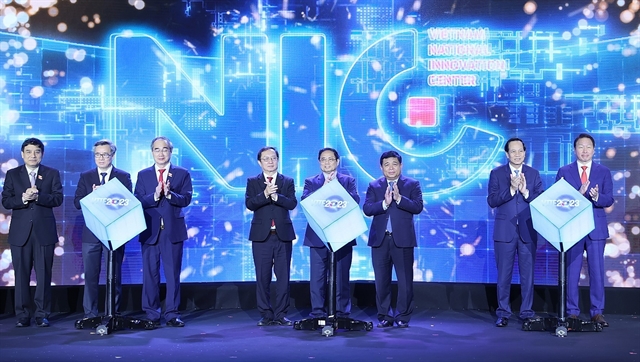The second and highly-anticipated facility of the National Innovation Centre (NIC)'s inauguration marks a milestone in establishing innovation ecosystem in Việt Nam.

The second and highly-anticipated facility of the National Innovation Centre (NIC) was inaugurated on Saturday at Hòa Lạc Hi-Tech Park in Hà Nội, marking a milestone in establishing the innovation ecosystem in Việt Nam.
The 20,000sq.m facility, designed in the form of an eagle, symbolises its mission to drive innovative ideas and create breakthrough values. The facility, initiated on January 9, 2021, stands as a testament to the Vietnamese Government's commitment to promoting innovation-based development.
Addressing the inauguration ceremony, Minister of Planning and Investment Nguyễn Chí Dũng said the centre stands out as one of the pioneering state-owned innovation centres globally, serving the common goals of the nation. The VNĐ1 trillion (US$41.7 million) facility operates under a specific mechanism regulated by a separate Government Decree and is entirely invested and operated with socialised capital.
These characteristics are expected to transform the centre into a nucleus driving the development of Việt Nam’s innovation ecosystem, enabling the country to seize the historic opportunity of the Fourth Industrial Revolution for a breakthrough.
“We can believe in a forthcoming surge in the advancement of Việt Nam’s innovation ecosystem where in the future the mention of innovation prompts the regional and global community to immediately think of Việt Nam,” Dũng said.
At the event, Prime Minister Phạm Minh Chính emphasised that innovation is an inevitable trend and a strategic choice crucial for the country's breakthrough towards strength and prosperity. Despite significant progress in science, technology, and innovation, the PM acknowledged that the progress has not fully aligned with the nation's potential, especially the intellectual and creative capacities of its people.
The PM has outlined a comprehensive strategy to advance innovation in Việt Nam, focusing on refining policies and institutions to support startups, particularly in key sectors like semiconductor technology, healthcare, education, and artificial intelligence. Additionally, there is an emphasis on developing strategies and plans for fields with high science and technology content, including the preparation of infrastructure and high-quality human resources to enhance industries and add value to Việt Nam.
Collaboration within the innovation ecosystem is crucial, with a spotlight on international cooperation. The PM encourages collaboration between domestic businesses and global technology corporations, inviting embassies, international organisations, and tech leaders to participate in programmes promoting investment and business cooperation within Việt Nam's innovation ecosystem.
The strategy also involves refining the development mechanisms and policies of the National Innovation Center (NIC), attracting investment partners, establishing research and development facilities at the new Hòa Lạc high-tech industrial park, and enhancing strategic infrastructure, particularly in transportation and services.
In the 2023 Global Innovation Index, Việt Nam rose two places to 46 out of 132 economies. This positive trend suggests that the NIC, particularly the Hòa Lạc facility, could become a key driver for innovation, reshaping the economy through scientific and technological development.
Francois Michel, CEO of John Cockerill and an exhibitor at Vietnam International Innovation Exhibition 2023, expressed to Việt Nam News that NIC will serve as a significant hub for the company in the Asia-Pacific region. He highlighted the NIC as a key location for implementing their most innovative programs and simulation teams.
While acknowledging that the NIC won't be the exclusive site for their research and development (R&D) activities in Việt Nam, Michel emphasised its importance, stating: "This is where we expect a lot of R&D to happen together with other companies that will invest in the NIC."
Michel sees great potential in Việt Nam's innovation ecosystem, predicting substantial growth in the coming years and decades. He attributes this optimism to the influx of companies attracted to Việt Nam, including John Cockerill, drawn by the robust human resources and talent base. Michel commends the country's long-term vision for political stability and sustainable growth, particularly in renewable energy and digital sectors. This clear vision encourages investments and reinforces the decision to establish key teams at the NIC.
Make-in-Vietnam 5G chip

In the Vietnam International Innovation Exhibition 2023 at the NIC Hòa Lạc Viettel Military Industry and Telecoms Group (Viettel) has announced a successful development – the first 5G DFE Chip in Việt Nam within the 5G product ecosystem entirely designed by Viettel engineers.
According to Viettel representatives, the 5G Chip is the most complex component of the 5G ecosystem, handling algorithms for 5G DFE, controlling all operations of 5G RRU (Receiving/Transmission Signal Unit), and ensuring high-speed communication with other 5G processing units. With a high level of complexity, the 5G DFE Chip boasts a computing capacity of 1,000 trillion calculations per second, earning recognition from reputable partners like Synopsys.
The global market currently lacks commercial 5G Chip products. Mastering the entire chip design process is a significant step for Việt Nam to deeply engage in the global semiconductor industry. This achievement positions Viettel to produce various chips for future applications, including AI, 6G, and IoT.
Viettel has long been strategically replacing imported devices and gradually transitioning to a fully self-manufactured telecommunications network core system. Before the successful development of the 5G Chip, Viettel collaborated with Qualcomm to research and produce the world's first 5G transceiver station block using ASIC chipset under the Open RAN standard.
This breakthrough is seen as an opportunity to revolutionise the telecommunications infrastructure equipment industry by potentially reducing costs and eliminating dependence on exclusive chipsets from global equipment manufacturers.
The utilisation of Make-in-Vietnam network devices will contribute to Việt Nam's technological autonomy, reduce reliance on foreign sources, and save foreign currency for the country. — VNS





